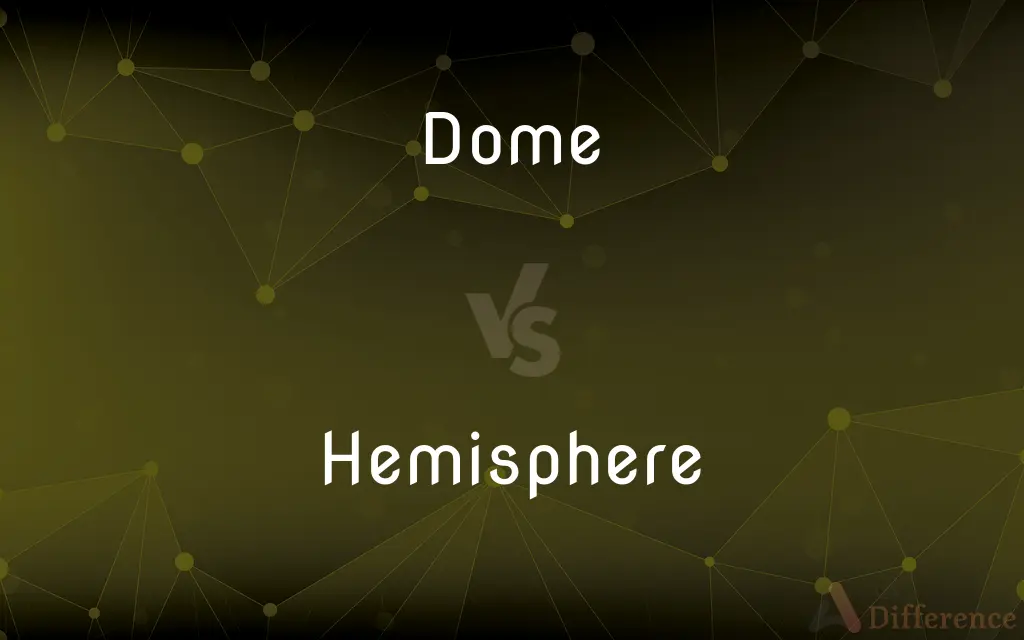Dome vs. Hemisphere — What's the Difference?
By Tayyaba Rehman & Fiza Rafique — Updated on March 29, 2024
A dome is an architectural element resembling half of a sphere, often used as a roof or ceiling, while a hemisphere is a precise half of a spherical shape, used in geographical and geometric contexts.

Difference Between Dome and Hemisphere
Table of Contents
ADVERTISEMENT
Key Differences
A dome, in architecture, refers to a rounded vault forming the roof of a building or structure, often semicircular or elliptical in shape when viewed from the inside. On the other hand, a hemisphere is strictly defined in geometry as one half of a sphere, divided by a plane passing through its center, applicable in various scientific fields such as geography, where it refers to one half of the Earth.
Domes are primarily used for their aesthetic appeal and the spacious interior they provide without needing internal supports, making them popular in religious and monumental architecture. Whereas hemispheres are a concept used to describe or analyze half of a spherical object or planet, emphasizing the division of the Earth into the Northern and Southern Hemispheres, or in astronomy to refer to celestial spheres.
The construction of a dome involves architectural design, engineering, and materials like concrete, brick, or steel, tailored to achieve both beauty and functionality in buildings. In contrast, the concept of a hemisphere is used in theoretical discussions and scientific calculations, such as understanding climate patterns or mapping the globe.
Domes can be adorned with art, windows, and other decorative elements that enhance their functionality and aesthetic value. Hemispheres, while not physical constructs, are crucial in understanding Earth's geography, climate zones, and cultural divisions, reflecting natural and human-made boundaries.
The engineering behind domes allows them to span large areas and support significant weight, a testament to human ingenuity in architecture. Conversely, the idea of a hemisphere serves as a foundational element in geography and astronomy, guiding navigation, weather forecasting, and the study of planetary bodies.
ADVERTISEMENT
Comparison Chart
Definition
An architectural element that resembles the upper half of a sphere.
One half of a spherical shape, divided equally by a plane.
Usage
Used as roofs or ceilings in buildings.
Used in geographical and geometric contexts.
Construction
Involves materials like concrete, brick, or steel.
Not constructed but used as a concept for analysis.
Functionality
Provides a spacious interior without internal supports.
Used to describe or analyze Earth's division or celestial bodies.
Application
Found in religious, governmental, and monumental buildings.
Applied in geography, astronomy, and various scientific fields.
Compare with Definitions
Dome
An architectural roof or ceiling with a circular base and a curved surface.
The dome of the cathedral dominates the city's skyline.
Hemisphere
One half of a sphere, divided by a central plane.
The Earth is divided into the Northern and Southern Hemispheres.
Dome
A structure resembling the upper half of a sphere.
The sports arena is covered by a massive dome.
Hemisphere
Crucial for navigation.
Hemisphere location determines the use of certain navigational stars.
Dome
Used to create spacious interiors in buildings.
Ancient Romans pioneered the use of domes in public baths.
Hemisphere
Applies to celestial bodies.
Observations of Mars cover both hemispheres to map its surface.
Dome
Can be made from various materials.
The geodesic dome is constructed from a network of triangles.
Hemisphere
Influences climate patterns.
The hemisphere a region is in affects its weather and climate.
Dome
Often decorated with art.
The dome's interior is adorned with intricate mosaics.
Hemisphere
Used in geographic context.
Countries in the Southern Hemisphere experience opposite seasons to those in the Northern.
Dome
A dome (from Latin: domus) is an architectural element similar to the hollow upper half of a sphere; there is significant overlap with the term cupola, which may also refer to a dome or a structure on top of a dome. The precise definition of a dome has been a matter of controversy and there are a wide variety of forms and specialized terms to describe them.
Hemisphere
A half of a sphere bounded by a great circle.
Dome
A roof or vault having a circular, polygonal, or elliptical base and a generally hemispherical or semispherical shape.
Hemisphere
A half of a symmetrical, approximately spherical object as divided by a plane of symmetry.
Dome
A geodesic dome.
Hemisphere
Either half of the celestial sphere as divided by the ecliptic, the celestial equator, or the horizon.
Dome
A domelike structure or object.
Hemisphere
Either the northern or southern half of the earth as divided by the equator or the eastern or western half as divided by a meridian.
Dome
A system of strata that is uplifted in the center, forming a concentric anticline.
Hemisphere
Either of the lateral halves of the cerebrum; a cerebral hemisphere.
Dome
A mass of granite that has been weathered into a rounded shape by exfoliation.
Hemisphere
Either of the lateral halves of the cerebellum; a cerebellar hemisphere.
Dome
A mound formed by the extrusion of viscous lava from a volcano.
Hemisphere
Half of the celestial sphere, as divided by either the ecliptic or the celestial equator .
Dome
(Chemistry) A form of crystal with two similarly inclined faces that meet at an edge parallel to the horizontal axis.
Hemisphere
(figuratively) A realm or domain of activity .
Dome
(Slang) The human head.
Hemisphere
(geography) Half of the Earth, such as the Northern Hemisphere, Southern Hemisphere, Western Hemisphere or Eastern Hemisphere, Land Hemisphere, Water Hemisphere etc. .
Dome
(Archaic) A large, stately building.
Hemisphere
(geometry) Any half-sphere, formed by a plane intersecting the center of a sphere. .
Dome
To cover with or as if with a dome.
Hemisphere
(cartography) A map or projection of a celestial or terrestrial hemisphere .
Dome
To shape like a dome.
Hemisphere
(anatomy) Either of the two halves of the cerebrum. .
Dome
To rise or swell into the shape of a dome.
Hemisphere
A half sphere; one half of a sphere or globe, when divided by a plane passing through its center.
Dome
(architecture) A structural element resembling the hollow upper half of a sphere.
Geodesic dome
Hemisphere
Half of the terrestrial globe, or a projection of the same in a map or picture.
Dome
(by extension) Anything shaped like an upset bowl, often used as a cover.
A cake dome
Lava dome
Hemisphere
The people who inhabit a hemisphere.
He died . . . mourned by a hemisphere.
Dome
(informal) A person's head.
Hemisphere
Half of the terrestrial globe
Dome
A building; a house; an edifice.
Pleasure dome
Hemisphere
Half of a sphere
Dome
(by extension) Any erection resembling the dome or cupola of a building, such as the upper part of a furnace, the vertical steam chamber on the top of a boiler, etc.
Steam dome
Hemisphere
Either half of the cerebrum
Dome
(crystallography) A prism formed by planes parallel to a lateral axis which meet above in a horizontal edge, like the roof of a house; also, one of the planes of such a form.
Dome
(geology) A geological feature consisting of symmetrical anticlines that intersect where each one reaches its apex.
Dome
(transitive) To give a domed shape to.
Dome
To shoot in the head.
That guy just got domed!
Dome
To perform fellatio on.
Dome
A building; a house; an edifice; - used chiefly in poetry.
Approach the dome, the social banquet share.
Dome
A cupola formed on a large scale.
Dome
Any erection resembling the dome or cupola of a building; as the upper part of a furnace, the vertical steam chamber on the top of a boiler, etc.
Dome
A prism formed by planes parallel to a lateral axis which meet above in a horizontal edge, like the roof of a house; also, one of the planes of such a form.
Dome
Decision; judgment; opinion; a court decision.
Dome
A concave shape whose distinguishing characteristic is that the concavity faces downward
Dome
Informal terms for a human head
Dome
A stadium that has a roof
Dome
A hemispherical roof
Common Curiosities
What is the primary purpose of a dome in architecture?
The primary purpose of a dome in architecture is to cover a large space without internal supports, providing a spacious interior and aesthetic appeal.
Can a dome be considered a hemisphere?
Architecturally, a dome can be considered to resemble a hemisphere, as it mimics the shape of half a sphere, but it's specifically designed for buildings and structures.
Why are hemispheres important in scientific studies?
Hemispheres are important in scientific studies for analyzing Earth's geography, climate patterns, celestial navigation, and understanding the distribution of continents and oceans.
How is a hemisphere defined in geography?
In geography, a hemisphere is defined as one half of the Earth, divided into the Northern and Southern Hemispheres by the equator, or the Eastern and Western Hemispheres by the prime meridian.
How do domes and hemispheres differ in their application?
Domes are applied in architecture as structural elements with practical and aesthetic purposes, while hemispheres are theoretical constructs used in geography, astronomy, and other sciences.
What architectural styles are known for their use of domes?
Architectural styles known for their use of domes include Byzantine, Islamic, Renaissance, and Baroque architecture.
What materials are commonly used to construct domes?
Common materials for constructing domes include concrete, brick, steel, and in modern constructions, transparent materials like glass or plastic for geodesic domes.
Can the concept of a hemisphere be applied to planets other than Earth?
Yes, the concept of a hemisphere can be applied to any spherical celestial body, such as planets and moons, to describe their halves for scientific analysis.
What are some famous examples of domes?
Famous examples of domes include the Pantheon in Rome, the Dome of the Rock in Jerusalem, and the United States Capitol in Washington, D.C.
How does the concept of a hemisphere help in understanding the Earth's climate?
The concept of a hemisphere helps in understanding Earth's climate by explaining seasonal variations, weather patterns, and the distribution of climate zones based on the planet's tilt and orbit.
Share Your Discovery

Previous Comparison
Installation vs. Setup
Next Comparison
Wagel vs. BagelAuthor Spotlight
Written by
Tayyaba RehmanTayyaba Rehman is a distinguished writer, currently serving as a primary contributor to askdifference.com. As a researcher in semantics and etymology, Tayyaba's passion for the complexity of languages and their distinctions has found a perfect home on the platform. Tayyaba delves into the intricacies of language, distinguishing between commonly confused words and phrases, thereby providing clarity for readers worldwide.
Co-written by
Fiza RafiqueFiza Rafique is a skilled content writer at AskDifference.com, where she meticulously refines and enhances written pieces. Drawing from her vast editorial expertise, Fiza ensures clarity, accuracy, and precision in every article. Passionate about language, she continually seeks to elevate the quality of content for readers worldwide.











































